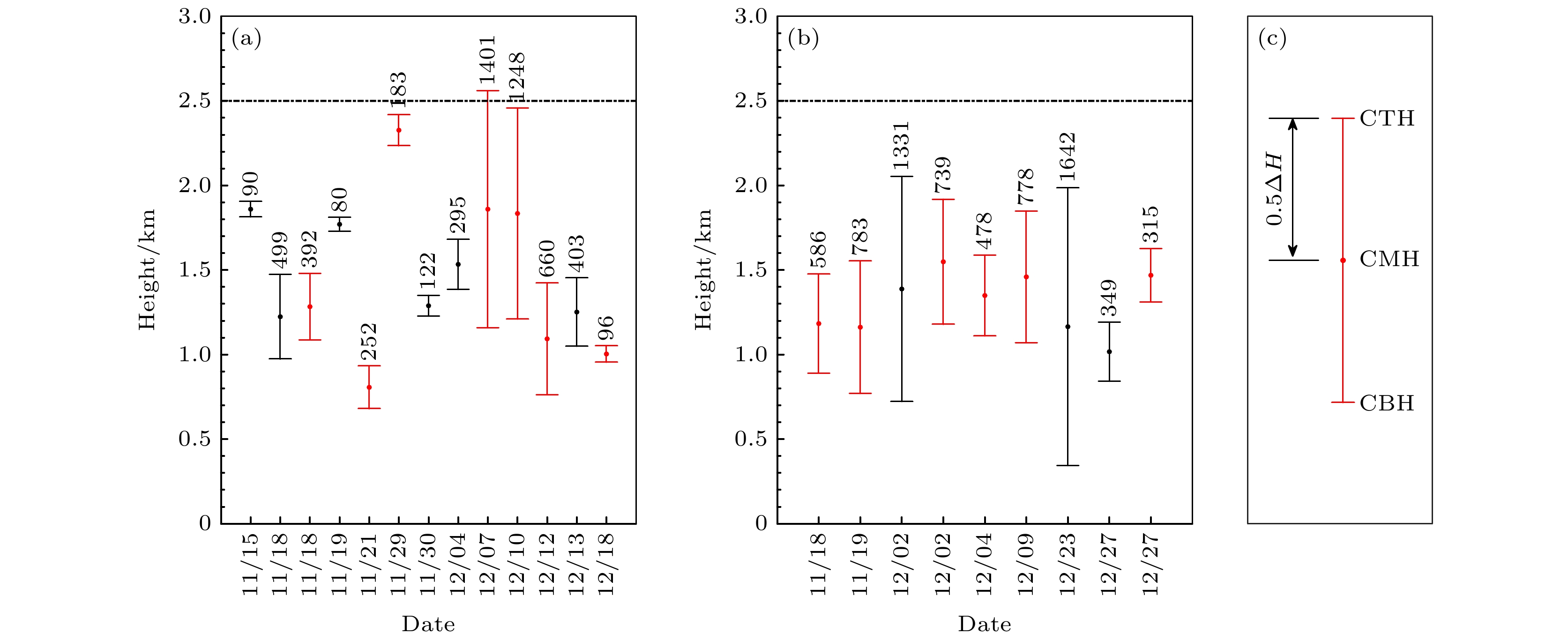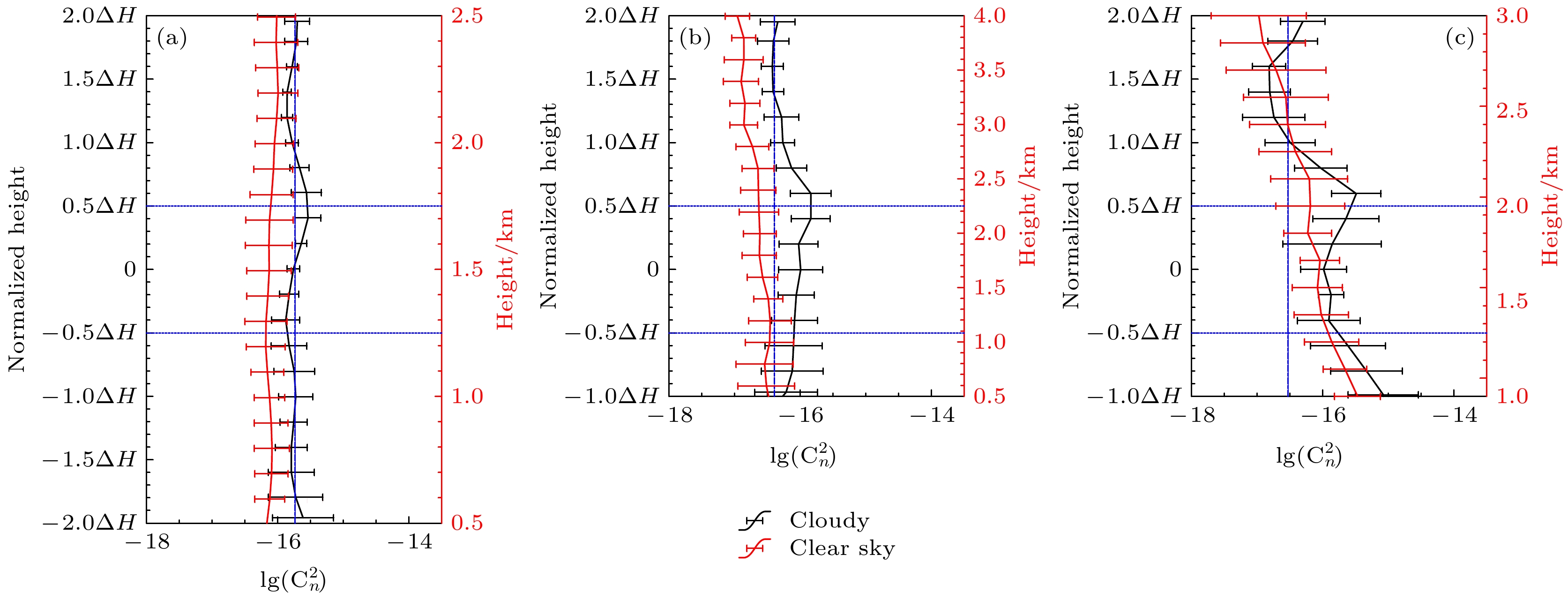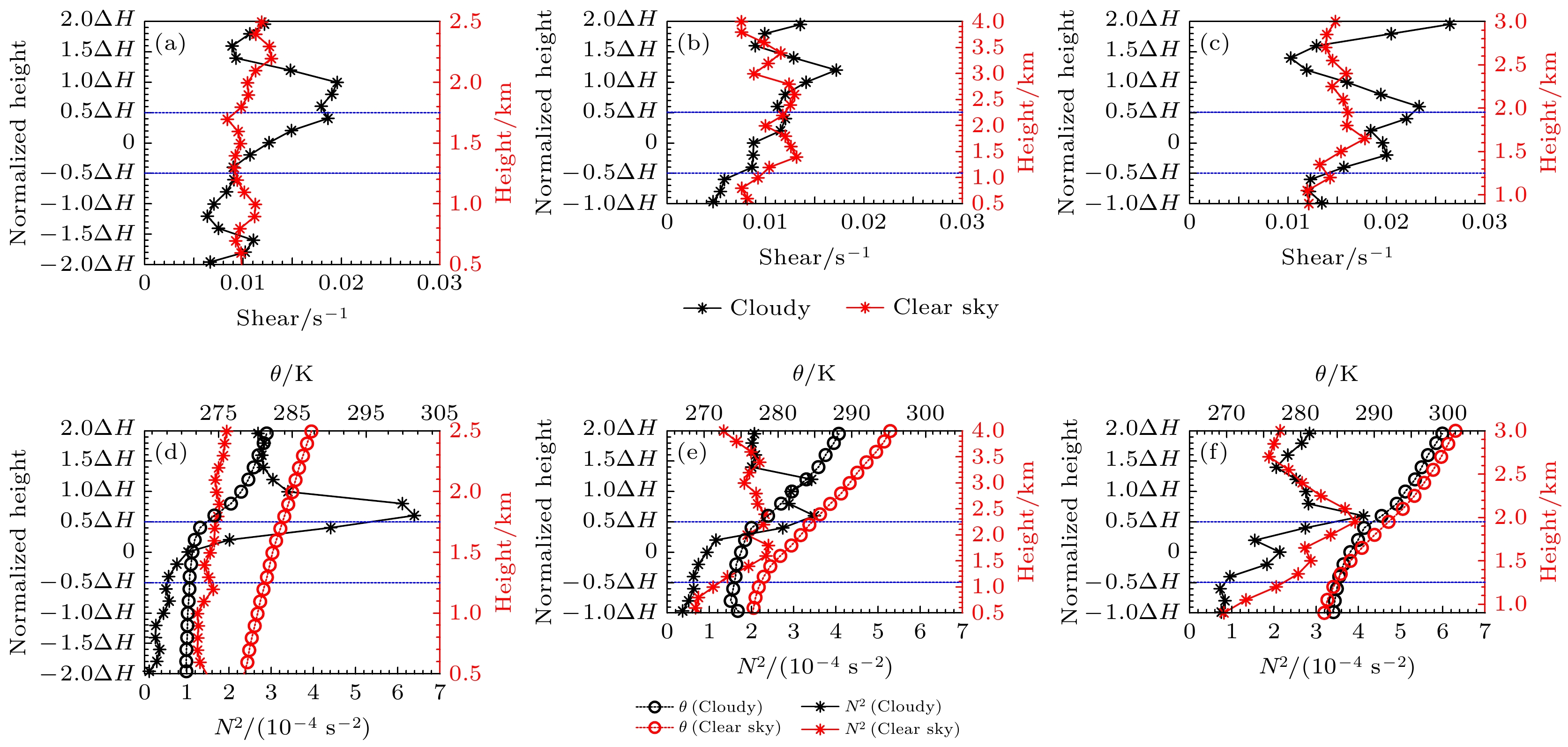-
Based on the measured thermal radiosondes, the WR95 method is used to identify the vertical structure of low clouds. The atmospheric refractive index structure constant
$C_{n}^2$ , meteorological conditions and atmospheric stability are contrastively analyzed under cloudy and clear sky weather. The results show that the influence of low-level thin clouds on the fluctuation of$ C_n^2 $ is negligible, showing only a slight increase trend. The$ C_n^2 $ at low-level thin clouds base and top is about 1.6 and 2.5 times that under clear sky weather to a greatest extent, respectively. The$ C_n^2 $ at the low-level medium-thick clouds top is 3.8–6.61 times the amplitude of that under clear sky weather, and enhanced amplitude of$ C_n^2 $ near the cloud top is greater than that near the cloud base. Atmospheric turbulence near the cloud base is driven by the combined effect of ground heat and low clouds cooling. The sinking airflow from clouds is coupled with the upward airflow from ground, which motivates wind shear, resulting$ C_n^2 $ increases near this height. A comprehensive comparison of the$ C_n^2 $ between clear sky and cloudy weather shows that the enhancement effect of clouds on$ C_n^2 $ is roughly on the order of 10–16. Wind shear reaches its maximum value at or above the cloud top. Because of the combined effect of short-wave radiation warming and long-wave radiation cooling near the cloud top, temperature inversion layers with different thickness will be formed obove the cloud top, resulting in a sharp increase in the potential temperature lapse rate at the cloud top, and the Brunt-Vaisala frequency$ {N^2} $ is increased by 0.5–3.0 times. And$ {N^2} $ near the cloud base is less than that under the clear sky weather. Owing to the turbulent effect caused by cloud multi-scale activities, it is inevitable to cause assessment and correction deviations in the laser transmission. A deep understanding of how turbulence behave within different phase clouds or around cloud boundaries can also lay the foundation for further modeling the atmospheric turbulence around clouds.-
Keywords:
- low clouds /
- atmospheric refractive index structure constant /
- radiosonde /
- turbulent enhancement effect
[1] Ipcc A R 2013 Clouds and Aerosols. In: Climate Change 2013: The Physical Science Basis. Contribution of Working Group I to the Fifth Assessment Report of the Intergovernmental Panel on Climate Change Report
[2] Bodenschatz E, Malinowski S P, Shaw R A, Stratmann F 2010 Science 327 970
 Google Scholar
Google Scholar
[3] Paredes Quintanilla M E, Abdunabiev S, Allegretti M, Merlone A, Musacchio C, Pasero E G A, Tordella D, Canavero F 2021 Sensors 21 1351
 Google Scholar
Google Scholar
[4] Stechmann S N, Stevens B 2010 J. Atmos. Sci. 67 3269
 Google Scholar
Google Scholar
[5] Driedonks A G M, Duynkerke P G 1989 Bound-Lay. Meteorol. 46 275
 Google Scholar
Google Scholar
[6] Blyth A M, Cooper W A, Jensen J B 1988 J. Atmos. Sci. 45 3944
 Google Scholar
Google Scholar
[7] Boing S J, Jonker H J J, Nawara W A, Siebesma A P 2014 J. Atmos. Sci. 71 56
 Google Scholar
Google Scholar
[8] Paluch I R 1979 J. Atmos. Sci. 36 2467
 Google Scholar
Google Scholar
[9] Bera S, Prabha T V, Grabowski W W 2016 J. Geophys. Res. Atmos. 121 9767
 Google Scholar
Google Scholar
[10] Brenguier J L, Pawlowska H, Schuller L, Preusker R, Fischer J, Fouquart Y 2000 J. Atmos. Sci. 57 803
 Google Scholar
Google Scholar
[11] Jeffery C A 2007 J. Geophys. Res. Atmos 112 D24S21
[12] Brost R A, Wyngaard J C, Lenschow D H 1982 J. Atmos. Sci. 39 818
 Google Scholar
Google Scholar
[13] Lilly D K 1968 Q. J. R. Meteorol. Soc. 94 292
 Google Scholar
Google Scholar
[14] Lane T P, Sharman R D, Trier S B, Fovell R G, Williams J K 2012 Bull. Am. Meteorol. Soc. 93 499
 Google Scholar
Google Scholar
[15] Siebert H, Franke H, Lehmann K, Maser R, Saw E W, Schell D, Shaw R A, Wendisch M 2006 Bull. Am. Meteorol. Soc. 87 1727
 Google Scholar
Google Scholar
[16] Wang D, Guo J, Xu H, Li J, Lv Y, Solanki R, Guo X, Han Y, Chen T, Ding M, Chen A, Bian L, Rinke A 2021 Atmos. Res. 254 105530
 Google Scholar
Google Scholar
[17] Hill A A, Feingold G, Jiang H 2009 J. Atmos. Sci. 66 1450
 Google Scholar
Google Scholar
[18] Stevens B 2010 J. Fluid Mech. 660 1
 Google Scholar
Google Scholar
[19] Paluch I R, Baumgardner D G 1989 J. Atmos. Sci. 46 261
 Google Scholar
Google Scholar
[20] Garcia-Zambrana A, Castillo-Vazquez C, Castillo-Vazquez B 2010 Opt. Express 18 5356
 Google Scholar
Google Scholar
[21] Andrews L C, Phillips R L, Yu P T 1995 Appl. Opt. 34 7742
 Google Scholar
Google Scholar
[22] Kazaura K, Omae K, Suzuki T, Matsumoto M, Mutafungwa E, Korhonen T O, Murakami T, Takahashi K, Matsumoto H, Wakamori K, Arimoto Y 2006 Opt. Express 14 4958
 Google Scholar
Google Scholar
[23] 王飞, 余佳益, 刘显龙, 蔡阳健 2018 67 184203
 Google Scholar
Google Scholar
Wang F, Yu J Y, Liu X L, Cai Y J 2018 Acta Phys. Sin. 67 184203
 Google Scholar
Google Scholar
[24] 季小玲, 肖希, 吕百达 2004 53 3996
 Google Scholar
Google Scholar
Ji X L, Xiao X, Lv B D 2004 Acta Phys. Sin. 53 3996
 Google Scholar
Google Scholar
[25] 肖黎明, 翁宁泉, 孙刚, 余申伟 中国专利 CN200610097731.8 [2008-06-04]
Xiao L M, Weng N Q, Sun G, Yu S W China Patent CN200610097731.8 [2008-06-04](in Chinese)
[26] Bufton J L 1975 A Radiosonde Thermal Sensor Technique for Measurement of Atmospheric Turbulence Report No. NASA TN D-7867
[27] McFarquhar G M, Cober S G 2004 J. Clim. 17 3799
 Google Scholar
Google Scholar
[28] Morrison H, McCoy R B, Klein S A, et al. 2009 Q. J. R. Meteorol. Soc. 135 1003
 Google Scholar
Google Scholar
[29] Poore K D, Wang J H, Rossow W B 1995 J. Clim. 8 550
 Google Scholar
Google Scholar
[30] Chernykh I V, Eskridge R E 1996 J. Appl. Meteorol. 35 1362
 Google Scholar
Google Scholar
[31] Wang J, Rossow W B 1995 J. Appl. Meteorol. 34 2243
 Google Scholar
Google Scholar
[32] Naud C M, Muller J P, Clothiaux E E 2003 J. Geophys. Res. Atmos. 108 4140
 Google Scholar
Google Scholar
[33] 周毓荃, 欧建军 2010 气象 36 50
Zhou Y Q, Ou J J 2010 Meteorol. Mon. 36 50
[34] Chylek P, Robinson S, Dubey M K, King M D, Fu Q, Clodius W B 2006 J. Geophys. Res. Atmos. 111 D20203
 Google Scholar
Google Scholar
[35] Cober S G, Isaac G A, Korolev A V, Strapp J W 2001 J. Appl. Meteorol. 40 1967
 Google Scholar
Google Scholar
[36] Yan W, Han D, Lu W, Lei X L 2012 Chin. J. Geophys. -Chin. Ed. 55 1
 Google Scholar
Google Scholar
[37] Goff J A 1957 Transactions of the American Society of Heating and Ventilating Engineers 63 347
[38] Zhang J, Chen H, Li Z, Fan X, Peng L, Yu Y, Cribb M 2010 J. Geophys. Res. Atmos. 115 D00k30
[39] 孙丽, 赵姝慧 2018 地球科学进展 33 85
 Google Scholar
Google Scholar
Sun L, Zhao S H 2018 Adv. Earth Sci. 33 85
 Google Scholar
Google Scholar
[40] 刘爽, 王慧, 黄奕武, 尹尽勇, 董林, 杨正龙, 邢闯 2018 海洋气象学报 38 69
Liu S, Wang H, Huang Y W, Yin J Y, Dong L, Yang Z L, Xing C 2018 J. Mar. Meteorol. 38 69
[41] 曹越男, 刘涛, 王慧, 杨正龙, 柳龙生 2018 海洋气象学报 38 76
Cao Y N, Liu T, Wang H, Yang Z L, Liu L S 2018 J. Mar. Meteorol. 38 76
[42] Wood R 2011 Mon. Weather Rev. 140 2373
[43] Zhang J, Chen H, Xia X, Wang W C 2016 Adv. Atm. Sci. 33 21
 Google Scholar
Google Scholar
[44] Bretherton C S, Wyant M C 1997 J. Atmos. Sci. 54 148
 Google Scholar
Google Scholar
[45] Ching J, Riemer N, Dunn M, Miller M 2010 Geophys. Res. Lett. 37 L21808
[46] Frisch A S, Lenschow D H, Fairall C W, Schubert W H, Gibson J S 1995 J. Atmos. Sci. 52 2800
 Google Scholar
Google Scholar
[47] Baker M B, Corbin R G, Latham J 2010 Q. J. R. Meteorol. Soc. 106 581
[48] Mellado J P 2017 Annu. Rev. Fluid. Mech. 49 145
 Google Scholar
Google Scholar
-
图 1 WR95法识别云层垂直结构示意图(2017年11月15日07:40在A站点的探空数据), 蓝色圆圈中即为厚度为20 m (小于30.5 m)的湿层
Figure 1. Schematic diagram of WR95 method to identify the vertical structure of clouds (Radiosonde at Station A lunched at 07:40 on November 15, 2017). The blue circle is the wet layer with a thickness of 20 m (less than 30.5 m).
图 2 WR95法识别低云垂直结构结果, 数字表示每个样本的云层厚度(单位为m) (a) A站点; (b) B站点, 黑色和红色分别代表早晨和晚上组; (c) 云层归一化高度示意图, 其中, 云层厚度
$\Delta $ H = HCT – HCB, “圆点”代表云中高度(cloud middle height, CMH(HCM)), HCM = (HCB+HCT)/2Figure 2. The WR95 method identifies the results of the vertical structure of low clouds, and the numbers indicate the thickness of the each cloud layer (unit: m): (a) Station A; (b) station B. Black and red represent the morning and evening groups, respectively; (c) schematic diagram of cloud normalized height. Where, cloud thickness
$\Delta $ H = HCT – HCB, and the dots represent the height of the cloud middle height (CMH(HCM)), HCM = (HCB+HCT)/2.图 3 A站点薄云和晴空天气下
$ C_n^2 $ 廓线对比 (a) 彩色实线分别表示四个薄云周围$ C_n^2 $ 廓线, 线上的彩色圆圈和*分别表示相应云层的CBH, CTH; (b) 四个薄云样本$ C_n^2 $ 与同时段晴空天气平均廓线的比值Ratio. (注:$ {\text{Ratio}} = {\log _{10}}({A_{C_n^2}}/{B_{C_n^2}}) $ ,$ {A_{C_n^2}} $ 为样本(有云)$ C_n^2 $ ,$ {B_{C_n^2}} $ 为对照组(晴空)$ C_n^2 $ Figure 3. Contrast of
$ C_n^2 $ profile under thin clouds and clear sky at Station A: (a) The colored solid lines indicate the$ C_n^2 $ profiles around the four thin clouds, the colored “o” and “*” on the lines indicate CBH and CTH of the corresponding clouds, respectively; (b)$ {\text{Ratio}} = {\log _{10}}({A_{C_n^2}}/{B_{C_n^2}}) $ .$ {A_{C_n^2}} $ is the$ C_n^2 $ of four thin clouds,$ {B_{C_n^2}} $ is$ C_n^2 $ of the control group under clear sky.图 6 A, B站点有云与晴空情况下气象条件(温度和风速)对比 (a), (d) A站点早晨组; (b), (e) A站点晚上组; (c), (f) B站点晚上组
Figure 6. Comparison of meteorological parameters (temperature and wind speed) for clouds and for clear sky at Station A and B: (a), (d) The morning group at Station A; (b), (e) the evening group at Station A; (c), (f) the evening group at Station B.
图 7 A, B站点有云与晴空天气下动力(风切变)和热力特征(Brunt-Vaisala频率和位温)对比 (a), (d) A站点早晨组; (b), (e) A站点晚上组; (c), (f) B站点晚上组
Figure 7. Comparison of dynamic (wind shear) and thermal characteristics (Brunt-Vaisala frequency and potential temperature) with clouds and clear sky: (a), (d) The morning group at Station A; (b), (e) the evening group at Station A; (c), (f) the evening group at Station B.
表 1 TD2型气象探空传感器参数
Table 1. Sensor parameters of TD2 type meteorological radiosonde.
测量参数 探测范围 探测精度 温度 +50— –90 ℃ ≤0.2 ℃ (+50— –70 ℃)
≤0.3 ℃ (–80— –90 ℃)气压 20—1060 hPa ≤1.5 hPa (500—1060 hPa)
≤0.7 hPa (5—500 hPa)相对
湿度1%—100% ≤ 4% (常温条件下)
≤8% (温度小于–25 ℃)风速 0—150 m/s < 0.3 m/s 风向 0—360° < 3° 表 2 2017年11月—12月A, B站点云垂直结构筛选结果(括号内表示“早晨组样本数量” + “晚上组样本数量”)
Table 2. Recognition results of the cloud vertical structure at Station A and B from November to December, 2017 (“sample number in the morning group” + “sample number in the evening group” in parentheses).
站点 探空总数量 晴空 低云 薄云
(厚度 < 0.15 km)中厚云
(0.15 km $\leqslant$ 厚度 $\leqslant$ 2 km)深对流云
(厚度 > 2 km)A 56(30 + 26) 33(19 + 14) 4 (3 + 1) 9 (3 + 6) 0 B 51(26 + 25) 31(16 + 15) 0 9 (3 + 6) 7 (1 + 6) 表 3 A, B站点云层垂直结构平均参数
Table 3. Average parameters of cloud vertical structure at Station A and B.
HCB/km HCT/km △H/km Station A (morning) 1.36 1.61 0.25 Station A (night) 1.16 1.76 0.6 Station B (night) 1.06 1.67 0.61 -
[1] Ipcc A R 2013 Clouds and Aerosols. In: Climate Change 2013: The Physical Science Basis. Contribution of Working Group I to the Fifth Assessment Report of the Intergovernmental Panel on Climate Change Report
[2] Bodenschatz E, Malinowski S P, Shaw R A, Stratmann F 2010 Science 327 970
 Google Scholar
Google Scholar
[3] Paredes Quintanilla M E, Abdunabiev S, Allegretti M, Merlone A, Musacchio C, Pasero E G A, Tordella D, Canavero F 2021 Sensors 21 1351
 Google Scholar
Google Scholar
[4] Stechmann S N, Stevens B 2010 J. Atmos. Sci. 67 3269
 Google Scholar
Google Scholar
[5] Driedonks A G M, Duynkerke P G 1989 Bound-Lay. Meteorol. 46 275
 Google Scholar
Google Scholar
[6] Blyth A M, Cooper W A, Jensen J B 1988 J. Atmos. Sci. 45 3944
 Google Scholar
Google Scholar
[7] Boing S J, Jonker H J J, Nawara W A, Siebesma A P 2014 J. Atmos. Sci. 71 56
 Google Scholar
Google Scholar
[8] Paluch I R 1979 J. Atmos. Sci. 36 2467
 Google Scholar
Google Scholar
[9] Bera S, Prabha T V, Grabowski W W 2016 J. Geophys. Res. Atmos. 121 9767
 Google Scholar
Google Scholar
[10] Brenguier J L, Pawlowska H, Schuller L, Preusker R, Fischer J, Fouquart Y 2000 J. Atmos. Sci. 57 803
 Google Scholar
Google Scholar
[11] Jeffery C A 2007 J. Geophys. Res. Atmos 112 D24S21
[12] Brost R A, Wyngaard J C, Lenschow D H 1982 J. Atmos. Sci. 39 818
 Google Scholar
Google Scholar
[13] Lilly D K 1968 Q. J. R. Meteorol. Soc. 94 292
 Google Scholar
Google Scholar
[14] Lane T P, Sharman R D, Trier S B, Fovell R G, Williams J K 2012 Bull. Am. Meteorol. Soc. 93 499
 Google Scholar
Google Scholar
[15] Siebert H, Franke H, Lehmann K, Maser R, Saw E W, Schell D, Shaw R A, Wendisch M 2006 Bull. Am. Meteorol. Soc. 87 1727
 Google Scholar
Google Scholar
[16] Wang D, Guo J, Xu H, Li J, Lv Y, Solanki R, Guo X, Han Y, Chen T, Ding M, Chen A, Bian L, Rinke A 2021 Atmos. Res. 254 105530
 Google Scholar
Google Scholar
[17] Hill A A, Feingold G, Jiang H 2009 J. Atmos. Sci. 66 1450
 Google Scholar
Google Scholar
[18] Stevens B 2010 J. Fluid Mech. 660 1
 Google Scholar
Google Scholar
[19] Paluch I R, Baumgardner D G 1989 J. Atmos. Sci. 46 261
 Google Scholar
Google Scholar
[20] Garcia-Zambrana A, Castillo-Vazquez C, Castillo-Vazquez B 2010 Opt. Express 18 5356
 Google Scholar
Google Scholar
[21] Andrews L C, Phillips R L, Yu P T 1995 Appl. Opt. 34 7742
 Google Scholar
Google Scholar
[22] Kazaura K, Omae K, Suzuki T, Matsumoto M, Mutafungwa E, Korhonen T O, Murakami T, Takahashi K, Matsumoto H, Wakamori K, Arimoto Y 2006 Opt. Express 14 4958
 Google Scholar
Google Scholar
[23] 王飞, 余佳益, 刘显龙, 蔡阳健 2018 67 184203
 Google Scholar
Google Scholar
Wang F, Yu J Y, Liu X L, Cai Y J 2018 Acta Phys. Sin. 67 184203
 Google Scholar
Google Scholar
[24] 季小玲, 肖希, 吕百达 2004 53 3996
 Google Scholar
Google Scholar
Ji X L, Xiao X, Lv B D 2004 Acta Phys. Sin. 53 3996
 Google Scholar
Google Scholar
[25] 肖黎明, 翁宁泉, 孙刚, 余申伟 中国专利 CN200610097731.8 [2008-06-04]
Xiao L M, Weng N Q, Sun G, Yu S W China Patent CN200610097731.8 [2008-06-04](in Chinese)
[26] Bufton J L 1975 A Radiosonde Thermal Sensor Technique for Measurement of Atmospheric Turbulence Report No. NASA TN D-7867
[27] McFarquhar G M, Cober S G 2004 J. Clim. 17 3799
 Google Scholar
Google Scholar
[28] Morrison H, McCoy R B, Klein S A, et al. 2009 Q. J. R. Meteorol. Soc. 135 1003
 Google Scholar
Google Scholar
[29] Poore K D, Wang J H, Rossow W B 1995 J. Clim. 8 550
 Google Scholar
Google Scholar
[30] Chernykh I V, Eskridge R E 1996 J. Appl. Meteorol. 35 1362
 Google Scholar
Google Scholar
[31] Wang J, Rossow W B 1995 J. Appl. Meteorol. 34 2243
 Google Scholar
Google Scholar
[32] Naud C M, Muller J P, Clothiaux E E 2003 J. Geophys. Res. Atmos. 108 4140
 Google Scholar
Google Scholar
[33] 周毓荃, 欧建军 2010 气象 36 50
Zhou Y Q, Ou J J 2010 Meteorol. Mon. 36 50
[34] Chylek P, Robinson S, Dubey M K, King M D, Fu Q, Clodius W B 2006 J. Geophys. Res. Atmos. 111 D20203
 Google Scholar
Google Scholar
[35] Cober S G, Isaac G A, Korolev A V, Strapp J W 2001 J. Appl. Meteorol. 40 1967
 Google Scholar
Google Scholar
[36] Yan W, Han D, Lu W, Lei X L 2012 Chin. J. Geophys. -Chin. Ed. 55 1
 Google Scholar
Google Scholar
[37] Goff J A 1957 Transactions of the American Society of Heating and Ventilating Engineers 63 347
[38] Zhang J, Chen H, Li Z, Fan X, Peng L, Yu Y, Cribb M 2010 J. Geophys. Res. Atmos. 115 D00k30
[39] 孙丽, 赵姝慧 2018 地球科学进展 33 85
 Google Scholar
Google Scholar
Sun L, Zhao S H 2018 Adv. Earth Sci. 33 85
 Google Scholar
Google Scholar
[40] 刘爽, 王慧, 黄奕武, 尹尽勇, 董林, 杨正龙, 邢闯 2018 海洋气象学报 38 69
Liu S, Wang H, Huang Y W, Yin J Y, Dong L, Yang Z L, Xing C 2018 J. Mar. Meteorol. 38 69
[41] 曹越男, 刘涛, 王慧, 杨正龙, 柳龙生 2018 海洋气象学报 38 76
Cao Y N, Liu T, Wang H, Yang Z L, Liu L S 2018 J. Mar. Meteorol. 38 76
[42] Wood R 2011 Mon. Weather Rev. 140 2373
[43] Zhang J, Chen H, Xia X, Wang W C 2016 Adv. Atm. Sci. 33 21
 Google Scholar
Google Scholar
[44] Bretherton C S, Wyant M C 1997 J. Atmos. Sci. 54 148
 Google Scholar
Google Scholar
[45] Ching J, Riemer N, Dunn M, Miller M 2010 Geophys. Res. Lett. 37 L21808
[46] Frisch A S, Lenschow D H, Fairall C W, Schubert W H, Gibson J S 1995 J. Atmos. Sci. 52 2800
 Google Scholar
Google Scholar
[47] Baker M B, Corbin R G, Latham J 2010 Q. J. R. Meteorol. Soc. 106 581
[48] Mellado J P 2017 Annu. Rev. Fluid. Mech. 49 145
 Google Scholar
Google Scholar
Catalog
Metrics
- Abstract views: 6328
- PDF Downloads: 70
- Cited By: 0


















 DownLoad:
DownLoad:





























